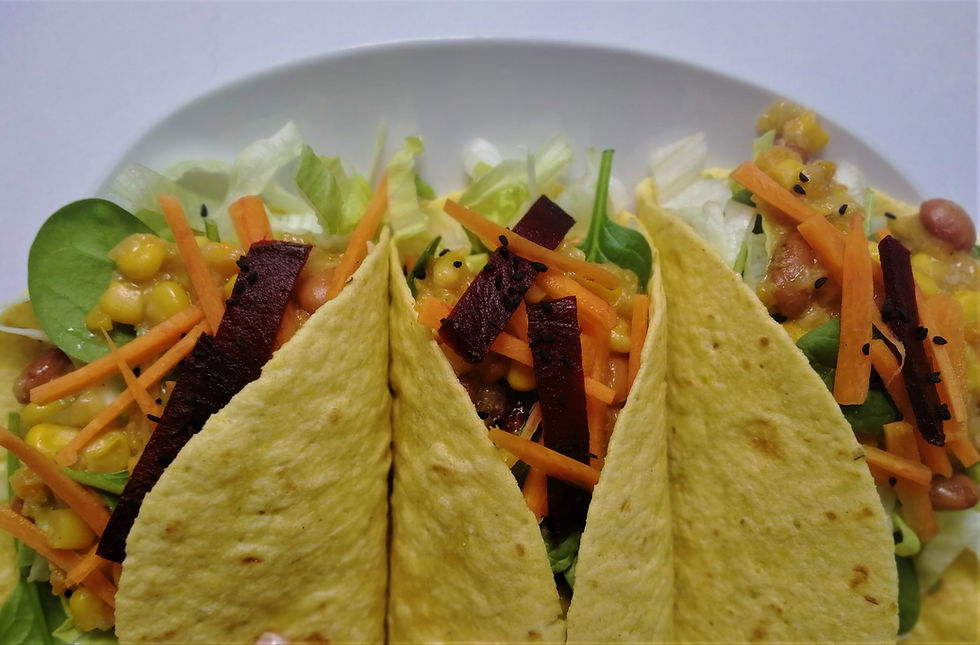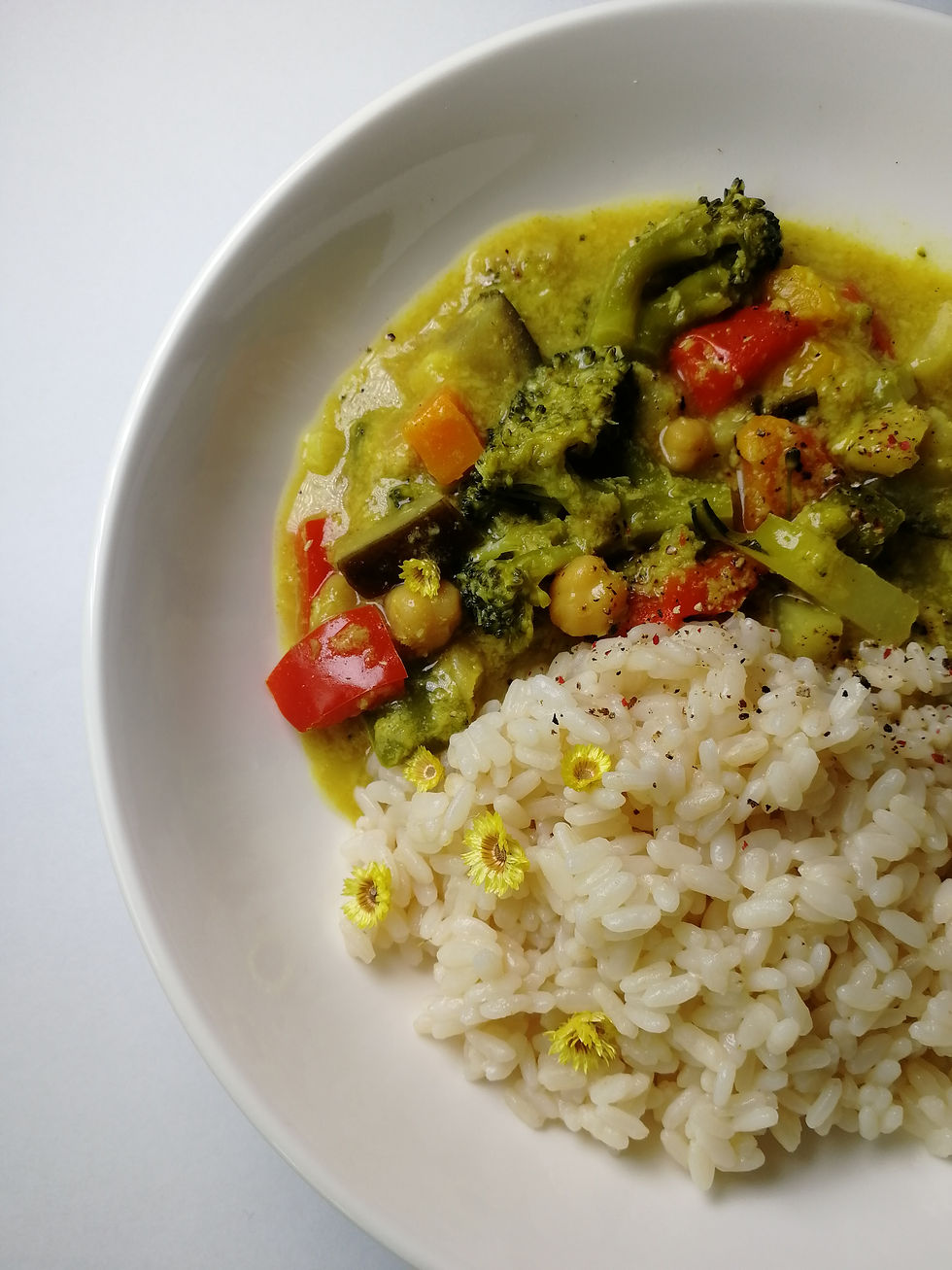Symphony of yellows
- Hungry Pumpkin

- May 30, 2019
- 7 min read
Updated: Feb 18, 2020
Creamy vegetable soup, curry-spiced sauerkraut with tofu, polenta, salad
Are you one of those people who rush around all day, skips lunch more often than you should, and forgets that you can't function as effectively on an empty belly? If so, you are not alone! But food is the basis of our lives, and it is important to remember to take time to incorporate it into our busy schedules.
If you are looking for a quick and cheap vegan meal you are going to love our meal today. This time, we started with a creamy vegetable soup, and continued with a dish of sauerkraut and tofu spiced with curry. We accompanied this tasty main dish with some simple-to-prepare instant polenta. In order to round out our lunch we also prepared a green salad. This sunny yellow meal is perfect to brighten up a cloudy day, and we think it really brings out the colours in our eyes, if we do say so ourselves :-)

Our hearty creamy soup's biggest charm is the ease of preparation; as long as you have a stick mixer or a blender you don't need to bother with tedious vegetable cutting that would eat up time in your busy day. To begin your soup, pan fry chunks of carrot, potato, broccoli, and leek (size depending on how much of a hurry you're in) in olive oil. Once the vegetables have softened up a bit and you think they have been sufficiently fried, add water, a bit of salt, and some spices such as marjoram or your other favourite herbs. After 15 minutes of boiling in the water, the fun begins! Take your stick mixer and blend the soup until it becomes creamy. Be careful though! Remove the soup from heat before you do this, and avoid having air bubbles under your mixer that may cause some hot soup to spray up. If you are cooking with kids this may be a good step to do yourself. Once you have done this, your soup is ready to serve! It can be eaten now or kept on a low heat burner until you are ready to serve.

While your soup is on the stove you can prepare the sauerkraut with tofu. Begin by cutting your tofu into the desired size and shape (we'd suggest small cubes) and pan frying them in olive oil (Eco tip: if you used too much oil when you pan fried the veggies for your soup you can reuse it now). Put the cubes in and gently sear each side until a slightly brown colour appears. You're then ready to add in the sauerkraut and to season with curry. Keep it on medium heat for about 10 minutes, stirring occasionally. If all of your water from the sauerkraut evaporates on the stove don't be afraid to add more to your pan!
Meanwhile, you can prepare your salad. Wash your lettuce leaves and cut them to desired size (we prefer ours nice and big; small pieces of lettuce can be a pain to get onto your fork). You can then toss these in a bowl with oil of your choice. We always have olive and pumpkin oil available in our stores, so we normally use a combination of these as they are both filled with the healthy fats that you want to be getting from oils.
How expensive is vegan food?
Many people think that vegan food is both very expensive to make and also does not sufficiently meet our nutritional needs; both of these, however, are incorrect. In buying seasonal fruits and vegetables and using lots of healthy staples such as legumes, rices, and whole-grain or normal pastas you can actually save a lot of money at the store as compared to buying animal products. Where things DO get expensive for vegans is when you start buying processed vegan-targeted products such as imitation meats (which are really usually just fancy tofu with some spices and a much larger price tag).
Our goal here is to now see how much money we spent on our lunch, and what the nutritional value is. We used ingredients from our local store, primarily using the store's own brands for products (a great way to cut costs). Only our polenta and pumpkin oil had to come from other brands.

Based on the products we bought and how much we used, we calculated that this lunch for 4 people cost us €3.89. That works out to less than €1 per person. Even at the cheapest of restaurants or cafés you wouldn't find a meal that cheap, especially not one that gives you so much food (most of us ate 2 servings) and that is so healthy!
How about we break down the prices now.
According to our calculations, the soup was half as expensive as the main dish. This price, however, will vary depending on the season and what vegetables you want to include. Adding more ingredients also increases the price. With a soup like this though, less is more. With everything blended together, you only need a few ingredients that will provide bulk and ideally provide a range of nutrients.
Let's talk nutritional value
Even though a well-balanced vegan diet can provide all that your body needs to be healthy and function normally, the question of protein is often raised (the cause of eye rolling among vegans and vegetarians all around the world).
To calculate the nutritional value of your food, there are a variety of online applications that you can use. We factored these values together using microsoft excel, which is a bit more time-consuming and complicated than using applications, but it gives us more flexibility and insight into the calculations. All food was carefully weighed (Carrots, broccoli, oil, salt, etc.) and each weight was divided by the number of portions (in our case, 4 people) to give us information about consumption for each individual. For example, in this lunch each person consumed about 50g of carrots, 37g of broccoli, etc. From this we calculated individual nutrients (proteins, fats, vitamin C, calcium, etc.) in all of the ingredients. We then compared the consumption with the daily recommended intake of nutrients. Daily requirements vary by individual, so we estimated based on the needs of a healthy, moderately active individual weighing 70kg.
Where do we get information on nutrient content in foods and data on human nutrient requirements?
Data on nutrient content in foods is derived from scientific literature written by researchers all over the world who carry out chemical analyses on food. Not only are these a great source of information, but they are THE source for information; these papers represent real data from actual scientists who specialise in the field. This is how doctors and dieticians learn about new information pertaining to nutrition. Next time you hear Donna from work talking about nutrition, listen politely... but then go fact check with the professionals.
The easiest way to find these articles is in online databases. One of the most comprehensive and easy-to-use of these is the US Department of Agriculture's database, which can be accessed free of charge at https://fdc.nal.usda.gov/ (2019). In this database not only can you find information by ingredient or dish, but you can also download the entire database onto your computer.
Just as wine varies by season or region, foods too will vary. Depending on the crop, the nutrient content can be quite different. Oranges, for example, contain on average 50mg of vitamiun C per 100g of weight; one shipment may have only 40mg, while another may have 70mg. Of course, this variation can't be accounted for unless every single bit of food you ate were to be chemically analysed (both a costly and time-consuming endeavour). As such, the calculations for nutrient values in food represent the best estimates that can be obtained.
Most of the data from our calculations were obtained from the US Department of Agriculture database that we mentioned before. Some data though wasn't sufficiently reliable, so we substituted directly with data from scientific literature. For example, they claim that buckwheat should only contain 12mg calcium per 100g dry weight, but previous scientific analysis has shown this amount to actually be much closer to 50mg (Ikeda, S., Yamashita, Y., and Kreft, I. [2000]. Essential mineral composition of buckwheat flour fractions. Fagopyrum 17, 57-61).
As for how much of what nutrients a healthy person needs, we use the recommendations from D-A-CH, the German, Austrian, and Swiss food associations' recommended values.

In our lunch here, the only protein food is tofu. That being said, other foods with less protein still contribute to our overall total. Though tofu is rich in protein, it is also 70% water, meaning that the protein content of tofu is not more than 16%. Our other foods in the meal, however, are not negligible sources of protein either; polenta is 8% protein. In consuming 50g of tofu we consumed almost 8g of protein and in eating 60g of polenta we gained almost 5g more. The salad and soup also contributed some protein, so in the end we each consumed over 18g of protein in this single meal. This represents 32% of the daily requirements for an average person. This meal included 530 kcal, which is 26% of our daily need for energy. When through other meals of the day the energy input would be 100%, we would most probably meet our protein requirements, with all of it coming from vegan sources that were cheap and healthy.
As with the proteins, our lunch also provided adequate amounts (at least 26%) of other nutrients such as lipids, all minerals, most vitamins, and each type of amino acid. Unfortunately, this meal lacked vitamins B12 and D, but this is easily aquired by drinking fortified soy or almond milk. We will continue writing about these tricky nutrients in future posts.
Our calculations also showed that we consumed too little panthothenic acid (only 18% of our daily requirement rather than the aim of 26%). This defecit could easily be ammended with the addition of foods such as sunflower seeds or varied full grain cereals that contain this substance. Some whole grain bread to dip in the soup or some seeds sprinkled on the salad would go a long way...
In addition to what we did eat, it is also important to mention what we DIDN'T eat. As with most vegan food, we consumed no cholesterol (your doctor will thank you for this one) and our intake of saturated fatty acids were well below harmful levels. It's also worth noting that our meal contained no wheat or other cereals containing gluten, making it appropriate for those with dietary restrictions preventing them from eating gluten.
For more detailed views of our nutritional calculations, you can click on The values.

For readers with a sweet tooth, you can make some vegan pancakes or vegan icecream as a reward for completing this yummy, cheap, and healthy vegan lunch with us. We don't have them today, but expect a special entry on vegan sweets soon!
Wishing you happy and healthy meals until next time!
The Hungy Pumpkin team






Comments